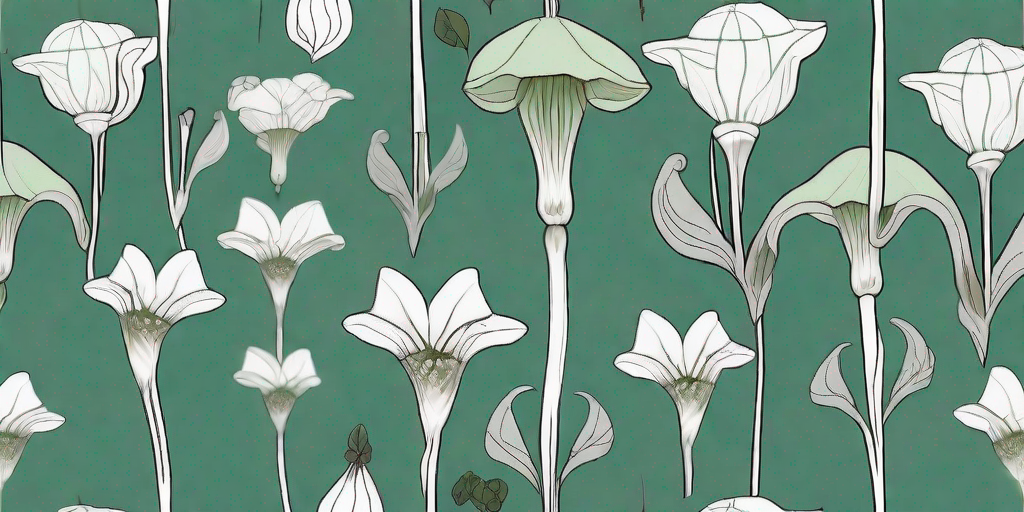
In the vast realm of flora, the Indian Pipe, also known as Ghost Plant or Corpse Plant, stands out as a unique and enigmatic wildflower. Its ethereal beauty, coupled with its intriguing survival strategy, makes it a fascinating subject for nature enthusiasts and botanists alike. So, buckle up, plant lovers! We're about to delve into the mysterious world of this captivating wildflower.
The Ghostly Appearance of Indian Pipe
First things first, let's talk about the striking appearance of the Indian Pipe. Unlike most plants, it completely lacks chlorophyll, which gives plants their green color. Instead, it sports a ghostly white or pale pink hue, hence the nicknames Ghost Plant and Corpse Plant. Its waxy, translucent stem holds a single, bell-shaped flower, which droops towards the ground, giving it a somewhat melancholic demeanor.
But don't let its somber look fool you. This plant is anything but ordinary. Its lack of chlorophyll means it can't photosynthesize like most plants. So how does it survive, you ask? Well, that's where things get really interesting.
The Unusual Survival Strategy of Indian Pipe
Indian Pipe has a unique survival strategy that involves a complex relationship with trees and fungi. It's a mycoheterotroph, which is a fancy way of saying it gets its nutrients from fungi, which in turn get their nutrients from trees. It's like a botanical version of a love triangle, only less dramatic and more symbiotic.
This survival strategy is not only unique but also incredibly efficient. It allows the Indian Pipe to thrive in dark, dense forests where sunlight is scarce. It's a testament to the adaptability of nature and a reminder that there's more than one way to survive in this world.
Where to Find Indian Pipe
Now that we've piqued your interest, you're probably wondering where you can find this enigmatic wildflower. Indian Pipe is native to North America, but it can also be found in Asia and Northern South America. It typically grows in dense, shady forests, particularly in areas with a lot of pine trees.
But remember, Indian Pipe is a bit of a diva. It doesn't like to be disturbed, so if you're lucky enough to spot one, admire it from a distance and resist the urge to pick it. Not only will this help preserve its habitat, but it will also give other nature enthusiasts a chance to marvel at its beauty.
Fun Facts About Indian Pipe
It's Not a Fungus
Despite its ghostly appearance and dependence on fungi, the Indian Pipe is not a fungus. It's a flowering plant, albeit a very unusual one. So, the next time someone mistakes it for a mushroom, you can impress them with your botanical knowledge.
It Turns Black When Disturbed
Remember when we said the Indian Pipe is a bit of a diva? Well, it takes its privacy very seriously. When disturbed, it turns black as a sign of protest. So, let's respect its space and admire it from a distance, shall we?
FAQs About Indian Pipe
- Is Indian Pipe rare?
While not considered rare, Indian Pipe can be hard to spot due to its preference for shady, undisturbed habitats. Plus, its ghostly white color can make it blend in with the forest floor.
- Can you grow Indian Pipe at home?
Indian Pipe is notoriously difficult to cultivate due to its dependence on a specific type of fungi. So, it's best to leave it in the wild where it belongs.
- Is Indian Pipe edible?
Despite its intriguing appearance, Indian Pipe is not considered edible. Some reports suggest it may even be mildly toxic, so it's best to admire it with your eyes, not your taste buds.
Conclusion
There you have it, folks! A deep dive into the mysterious world of the Indian Pipe. This enigmatic wildflower is a testament to the adaptability and diversity of nature. Its ghostly appearance, unusual survival strategy, and intriguing behavior make it a fascinating subject for nature enthusiasts and botanists alike.
So, the next time you're in a dense, shady forest, keep an eye out for this ghostly beauty. Who knows? You might just stumble upon one of nature's most captivating secrets.















